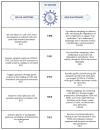Autophagy and Programmed Cell Death Modalities Interplay in HIV Pathogenesis
- PMID: 40072080
- PMCID: PMC11899401
- DOI: 10.3390/cells14050351
Autophagy and Programmed Cell Death Modalities Interplay in HIV Pathogenesis
Abstract
Human immunodeficiency virus (HIV) infection continues to be a major global health challenge, affecting 38.4 million according to the Joint United Nations Program on HIV/AIDS (UNAIDS) at the end of 2021 with 1.5 million new infections. New HIV infections increased during the 2 years after the COVID-19 pandemic. Understanding the intricate cellular processes underlying HIV pathogenesis is crucial for developing effective therapeutic strategies. Among these processes, autophagy and programmed cell death modalities, including apoptosis, necroptosis, pyroptosis, and ferroptosis, play pivotal roles in the host-virus interaction dynamics. Autophagy, a highly conserved cellular mechanism, acts as a double-edged sword in HIV infection, influencing viral replication, immune response modulation, and the fate of infected cells. Conversely, apoptosis, a programmed cell death mechanism, is a critical defense mechanism against viral spread and contributes to the depletion of CD4+ T cells, a hallmark of HIV/AIDS progression. This review aims to dissect the complex interplay between autophagy and these programmed cell death modalities in HIV-induced pathogenesis. It highlights the molecular mechanisms involved, their roles in viral persistence and immune dysfunction, and the challenges posed by the viral reservoir and drug resistance, which continue to impede effective management of HIV pathology. Targeting these pathways holds promise for novel therapeutic strategies to mitigate immune depletion and chronic inflammation, ultimately improving outcomes for individuals living with HIV.
Keywords: HIV; apoptosis; autophagy; ferroptosis; necroptosis; pyroptosis; xenophagy.
Conflict of interest statement
The authors declare that this research was conducted in the absence of any commercial or financial relationships that could be construed as a potential conflict of interest.
Figures
References
-
- Homepage. [(accessed on 28 December 2024)]. Available online: https://www.unaids.org.
Publication types
MeSH terms
Grants and funding
LinkOut - more resources
Full Text Sources
Medical
Research Materials


